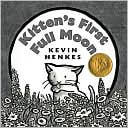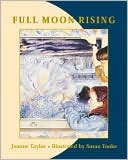 Henkes, Kevin.
Henkes, Kevin.Kitten's First Full Moon.
2004.
Greenwillow Books.
Guided Reading Level: G
For the first time ever, Kitten is experiencing a full moon! As she sits on the porch steps and notices it, she believes it to be a little bowl of milk in the sky and is determined to have it. So, Kitten sets off in hopes of finding the bowl of milk. She travels through the pasture, the garden, and around a pond to reach the bowl of milk. As she climbs a tree hoping to reach it, Kitten discovers the that another bowl of milk is in the middle of the pond. What she doesn't realize is that the bowl of milk in the pond is really a reflection of the bowl of milk from the sky (which is really the full moon)! Kitten dives in, hoping to reach the bowl of milk and comes out wet, sad, tired and just plain hungry. Setting back towards home, Kitten is surprised and happy to find that someone has set out a great big bowl of milk for her.
Little ones are sure to love this 2005 Caldecott Medal winner! The black and white illustrations set the mood for nighttime and it is easy to see how kitten could have mistaken the moon for a bowl of milk in the distance. This book could easily set the mood for a discussion about how sometimes when we look at the sky, we see other objects (the constellation formations, the shapes that clouds sometimes take, etc.).
Lesson Plans/Reading Activities:
- The World of Kevin Henkes: A Picture Book Guide
- Kitten's First Full Moon Activities
- Kitten's First Full Moon Lesson Plan - Scholastic
 Taylor, Joanne.
Taylor, Joanne.Full Moon Rising.
2002.
Tundra Books.
Following a farming family throughout the course of a year, Taylor expresses the ways in which this family names the moon based on the patterns in their life.
This book is very interesting, as I never before was familiar that different names were given to full moons based the month and family values. I really enjoyed this and I think it would be interesting to have students and families write their own version of Full Moon Rising, based on their family traditions!
Lesson Plans/Reading Activities
 Rylant, Cynthia.
Rylant, Cynthia.
Tundra Books.
Following a farming family throughout the course of a year, Taylor expresses the ways in which this family names the moon based on the patterns in their life.
June - HONEY MOON - June's moon is the Honey Moon. We celebrate when our cousin gets married. People used to drink mead, brewed from honey, at wedding feasts. But we're having strawberry punch. We make a toast to the bride and groom. Long life! Happy life!The pattern is followed through all twelve months of the year and really helps children see how the full moon has received the name it has been given!
This book is very interesting, as I never before was familiar that different names were given to full moons based the month and family values. I really enjoyed this and I think it would be interesting to have students and families write their own version of Full Moon Rising, based on their family traditions!
Lesson Plans/Reading Activities
 Rylant, Cynthia.
Rylant, Cynthia.Long Night Moon.
2004.
Simon & Schuster Books for Young Readers.
Similar to Joanne Taylor with Full Moon Rising, Cynthia Rylant, in Long Night Moon again introduces readers to the idea of how the full moons received their name. In her rendition, Rylant uses the chooses which names she will use, but only after explaining that the tradition stemmed from Native Americans who gave names to full moons.
Lesson Plans/Reading Activities:
Simon & Schuster Books for Young Readers.
Similar to Joanne Taylor with Full Moon Rising, Cynthia Rylant, in Long Night Moon again introduces readers to the idea of how the full moons received their name. In her rendition, Rylant uses the chooses which names she will use, but only after explaining that the tradition stemmed from Native Americans who gave names to full moons.
In March a Sap Moon rises over melting ponds, sleepy bears, small green trees.It tells a promise and a hope. I have to say that between the two, this one appealed to me more because the charcoal, pencil and pastel illustrations depicted the full moon throughout, where as in Full Moon Rising, the illustrations depicted the events that resulted in the moons name being what it was.
Lesson Plans/Reading Activities:
If you're interested in finding out more information about any of the books reviewed or if you'd like to purchase the books, click the cover image for a link to Amazon.com.








0 comments:
Post a Comment